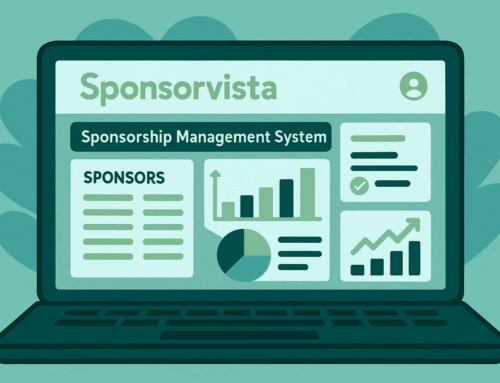All about Sponsorship

Sponsorship for your Association Starts Here
Effective sponsorship begins with proper management. By registering your association with SponsorVista, you immediately establish a strong foundation: automatic invoicing, clear communication with sponsors, and everything neatly recorded in one place. This way, you won’t lose information when volunteers change, and our system automatically sends you new sponsorship requests from companies interested in sponsoring you.
Whether you’re just starting or have been involved in sponsorship for years: in this article, you’ll learn everything about the forms of sponsorship, how to attract sponsors, and how to maximize your sponsorship deals with professional sponsor management via SponsorVista.
Discover the benefits and register today.
What is Sponsorship?
The definition of sponsorship is the provision of (financial) support to an organization or person in exchange for acquiring commercial publicity. That’s a mouthful.
Essentially, it concerns a business agreement between two parties where the sponsor provides a financial contribution, services, or other assets to the other party. These are often associations or foundations, but artists, athletes, and cultural organizations can also be dependent on sponsorship.
Sponsorship for Associations and Foundations
An association and society go hand in hand. Associations have a social purpose such as: jointly engaging in sports, making music, or pursuing a hobby. More than 30% of the Dutch population is a member of a sports association.
Associations and foundations typically have limited financial resources and are dependent on volunteers and sponsors to achieve their social objectives and ambitions. These associations and foundations therefore benefit from financial contributions or goods and services. Companies can assist these organizations by providing financial resources, or goods and services. In short: by sponsoring.
Sponsorship for Businesses
For businesses, sponsorship is interesting because associations and foundations represent a clear target audience. The local baker and butcher can sponsor an association in exchange for publicity among its members. These types of businesses transfer money in exchange for weekly or monthly publicity.
Sponsorship can also take the form of goods or services. In this case, no money is paid by the sponsor; instead, the sponsor provides goods or services to the association. For the sponsor, it’s a small gesture because it’s their work, and it saves the association a lot of money.
Why Do Associations and Foundations Seek Sponsorship Income?
Associations and foundations are non-profit organizations with a social objective. Usually, the primary source of income is member contributions. However, costs are continuously rising. Associations face increasing expenses due to heating, gas, inflation, higher material costs, and other factors. Contributions are getting higher and higher, and the fear that members can no longer afford or are unwilling to pay is growing.
Acquiring sponsorship is therefore a solution. Associations have a target audience that is interesting for many businesses. In exchange for publicity, associations can secure a sponsorship deal to increase their income.
This way, they retain more financial resources, for example, to keep contributions affordable, or to employ paid staff to help keep the association running. This directly addresses the volunteer shortage.
What are the Types of Sponsorship?
Sponsorship is a broad concept, and the possibilities are diverse. The forms of sponsorship can be summarized in the categories below:
- Sponsorship in the Form of Money / Financial Contribution
- In-kind Sponsorship
- Sponsorship in the Form of Promotion
Sponsorship in the Form of a Financial Contribution
The most common variant is that a sponsor provides a financial contribution in exchange for promotion. Many sports associations, for example, print a sponsor logo on the match shirts. In exchange for the shirt costs, the sponsor receives additional promotion for their company and brand, and the players get to play in new shirts. Additionally, a sponsor board is often used in exchange for sponsorship income.
Tip
Reserve the best spot for a sponsor board for the newest sponsor. This way, a sponsor board hangs in a prominent location for the first few weeks, giving them extra attention. Take a photo of it, send it to the sponsor, and offer even more value as an association.
In-kind Sponsorship
In-kind sponsorship is less common, but it is very interesting for associations. With in-kind sponsorship, the sponsor does not transfer money but provides services or goods. It is interesting for these companies because they can offer services or goods “cheaply” by only paying the cost price.
Tip
For example, consider an administrative office that updates the association’s administration for a few hours each month. This saves volunteers a tremendous amount of time, and the administrator does it much more efficiently and probably better. In return, the association or foundation promotes the administrative office to its target audience.
Sponsorship in the Form of Promotion
The last variant is interesting for, for example, artists and events. An artist or event organizer can ask the local/national newspaper, influencers, or local radio to bring their performance or event to attention. In return, the artist or event promotes the sponsor. No money is transferred between parties for this.
Please Note
For in-kind or promotional sponsorship, an invoice must still be sent. The association or foundation then sends an invoice for the in-kind sponsorship (e.g., EUR 1,000 per year for the promotion of the administrative office), and the administrative office sends an invoice back for EUR 1,000 for the services rendered. This is mandatory for correct VAT settlement. Even if your association is exempt from VAT, this is an obligation because the sponsor is usually subject to VAT.
Why Do Companies Want to Sponsor?
For many companies, it is interesting to sponsor. Large companies such as Jumbo, Visma, and Heineken are known for sponsoring extensively. However, these companies are generally not of interest to the average local association.
But don’t worry, (small) associations are also interesting for many companies. These associations have a local and centralized character. Many companies advertise in local newspapers, on social media, and on the radio. They pay a lot of money for that. Sponsoring an association is a cost-effective addition to this.
Sponsors generally have the following motivations for sponsoring an association:
- Personal Reasons
- Commercial Reasons
- Social Reasons
- Other Reasons
Personal Reasons
By far the largest group of sponsors have a personal reason to sponsor. This is because an entrepreneur likes to see his or her child play in a new uniform. These sponsors require little effort as they expect little promotion or reciprocal services. Ask within the association if anyone knows someone who wants to sponsor. There is always someone friends with an entrepreneur who is willing to sponsor a few hundred euros per year.
Tip
Review the member list and check the email addresses. Entrepreneurs or individuals in high decision-making positions within a company sometimes use their work email address. Check which members (including youth) do not use @gmail.com, @hotmail.com, or another email provider. You can then approach them to see if they would be interested in sponsoring.
Commercial Reasons
Not every sponsor has a personal connection with the association or foundation. The association has enough to offer to make sponsorship interesting. Offer the opportunity to advertise on your website, in the newsletter, the program booklet, social media, or even direct WhatsApp messages to members (do ask for your members’ permission first!). This offers great value to the entrepreneur.
Social Reasons
Many companies are facing stricter laws and regulations from the European Union. One of these rules is that companies must report on their performance in Environment, Social, and Governance (ESG) areas. It is therefore becoming increasingly interesting for companies to actively demonstrate that they practice corporate social responsibility.
Associations and foundations can capitalize on this because they inherently have a social objective and can utilize financial support.
Companies can provide this financial support in exchange for promotion and advertising. Furthermore, companies can simultaneously demonstrate to their customers, suppliers, and shareholders that they have the best interests of society at heart and support your objectives.
Tip
Send the sponsor a thank-you annually. This can be in the form of a photo on canvas where their name or logo is clearly visible during the activity. Sponsors can then display this photo when they receive clients and suppliers at their office. A small gesture, with a big impact.
Other Reasons to Sponsor
The labor market is tighter than ever. Companies are finding it increasingly difficult to find staff. Recruitment companies capitalize on this by searching for suitable candidates at great expense. Small businesses do not have the resources for this.
As an association, you can offer sponsors to share their vacancies within your network. You can offer the local baker or butcher to share their vacancy with your xxx members, 60% of whom are between 14 and 21 years old.
Or in the case of the local hairdresser: don’t you have members currently pursuing hairdressing training? You can connect them. Regarding sponsorship, you could agree to sign a sponsorship deal for the next 5 years, for example, once you manage to fill the vacancy from within the association’s network. A win-win situation for both the sponsor and the association.
Company Reputation and Sponsorship
A sponsor’s reputation is of vital importance, so it is crucial to realize the impact of your association on the sponsor’s reputation.
Once the sponsorship deal is finalized, you can get to work. However, be aware of the reputational damage and the risk a sponsor faces. If your association makes a mistake and receives negative media attention, it will also affect the sponsor. For example, if a team started a fight during Saturday’s match and a photo of the team (with sponsor branding) appears in the newspaper the following Monday, people will also form a negative impression of the sponsor.
Be vigilant about this and collectively strive for the best. Be aware of your association’s reputation and image and how that affects sponsorship. Reputation takes a long time to build but can be lost in a short time.
Trends in Sponsorship
In recent years, we have observed that companies are approaching sponsorship more and more professionally. The years when they annually transferred an X amount and asked for little in return are over.
Today, the competition for consumer attention is growing ever fiercer. Just consider for yourself how many hours you spend on Facebook, Instagram, TikTok, news apps, etc. Everywhere you see continuous commercial expressions from companies. Your sponsors also have to squeeze in there, and that costs a lot of money.
Companies therefore increasingly expect a reciprocal service for their sponsorship. Customization is important here. For each sponsor, consider what you can offer to surprise them. The moment you are surprising to the sponsor and can offer actual value, it can lead to a long-term collaboration.
Finally, Corporate Social Responsibility is becoming increasingly important. As mentioned earlier, companies must report on this to stakeholders, and associations can contribute to this.
Conclusion
Sponsorship is more relevant than ever. For associations and foundations, sponsorship is a great opportunity to deliver value to sponsors and thereby acquire additional financial resources. For sponsors, it is an opportunity to work on their brand awareness, reputation, and simultaneously gain additional advertising.
Curious how you can improve sponsor management and generate more income for your association? Download the brochure.





